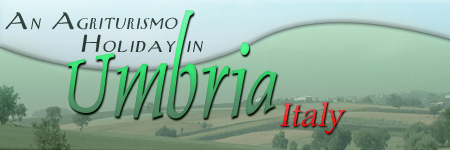
Explore Rich History in the "Green Heart of Italy"
by
Mary Beth Acosta
Entering the fire-warmed room, he places his precious bundle in its wrought iron cradle and picks up an extremely sharp knife. With great care he begins to shave off paper-thin slices of prosciutto; they fall like ribbons on the platter. “In the beginning, the mother pig and the father pig make love many times…” Giulio Mancini, proprietor of Agriturismo San Christoforo, dapper in his olive-green suit, is waxing poetic about the origin of our delicious lunch. It seems everything in Umbria has a lavish story, even the ham.
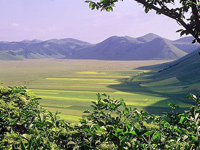 |
Often referred to as the, “Green Heart of Italy,” the region of Umbria is blessed with a rich history. The Umbrii people founded many Umbrian towns during the Iron Age around 1000 BC; the still vibrant city of Amelia predates Rome by almost 300 years. What followed is a multi-layered record of civilization: Etruscan foundations support Roman ruins topped by medieval hill towns. Lying on a route between Roma and Florence, Umbria expresses the classic landscape of Italy with rolling hills topped with medieval hamlets, Roman aqueducts spanning forested valleys, rows of Cyprus trees, centuries old farm buildings, vineyards and silvery colored olive groves. Much of Umbria’s bucolic character has remained untouched. Leaving the bustle of Roma behind, my rental car is taking me, and 100 kilometers an hour, into the past.
My agriturismo vacation, quite literally a "farm holiday", promises immersion into the rural Umbrian culture. My lodging will be in timeless stone farmhouses. Local wines will be generously poured. Meals will be authentic homemade Umbrian fare: crusty unsalted loaves of bread, seasonal vegetables from manicured gardens, mushrooms gathered from nearby woods (including the elusive and delicious truffle), delectable homemade pasta made from wheat grown in the field outside my shuttered window, even a resident hog or two. The very finest olive oil in the world, Olio di Oliva Extravergine, will be my constant dinner companion, soaking breads and gracing salads and pasta dishes. I will be more than just a tourist, I will be a guest of Umbria.
The term agriturismo identifies a type of Italian tourism that allows working farms to take in tourists, akin to a bed and breakfast. In theory, bringing tourists into the farming communities helps keep family farms alive by cushioning the negative effects of the fluctuating and ever fickle farm economy.
In practice, this Italian response to community tourism opens a unique portal for travelers to enter into the homes and hearts of the Umbrian people. Although law limits the number of guests and regulates the agriculture/tourist balance, an agriturismo property is an expression of the proprietors, the resident farming family.
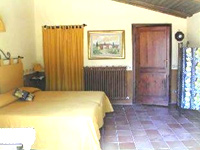 |
Nestled on the slope of Mount Subasio, just two miles east of St. Francis of Assisi’s noted cathedral, Malvarina County Inn provides the quintessential agriturismo experience. Three generations of the Maurillo family work side by side to make you feel right at home. With a presence belying her petite stature, owner Maria Maurillo lades the table with her Umbrian home cooking, as well as teaching classes in traditional regional fare. Her son, Claudio Fabrizi, and his wife Patricia manage the day-to-day affairs of running the 18th century farm, including the grounds, gardens, vineyards and olive trees. Claudio’s other passion is for horses, and he delights in escorting guests on riding tours. These treks can last for a day or may involve visiting five different agriturismo properties over as many days. The Malvarina County Inn’s future is assured by their son, 17 year old Phillipio, who is studying tourism at school and takes an active role and interest in running every aspect of the business. Claudio boasts Malvarina is, “your house in the country,” and this gracious family works to make this true.
As at Malvarina, it’s often the matriarch of the family who rules the kitchen and determines the flavor of the property. Gabriella Moscati, who owns and runs Fattoria di Vibio with her two sons, is another notable example. Raised near Sicily, she brings a southern Italian essence to her Umbrian table. The results are an absolute gastronomic delight. After an exquisite dinner ushered in with truffles and culminated with chocolate, Gabriella treated me to her philosophy of food and cooking.
“Cooking is not only the preparation of the food, but also the atmosphere that it gives to the family. It’s the tradition of food that matters,” she explains. “Now that I am older, the most important work for me is to transmit this love for food to the people that work for me.” Gourmands everywhere should be grateful that one of the offerings at Fattoria di Vibio is cooking classes taught by this talented and delightful woman.
The peacefulness of arriving at the Agriturismo La Casella near Orvieto quickly makes you forget the eight miles of twisting, jaw jarring road that you must take to get there. “It’s not just my job, I’m not just the owner, La Casella is my life, my son, my creation,” professes Luciano Nenna, who owns this property with best friend Tommaso Campolmi. “We put together the farming community with tourism to promote an international understanding of our culture, the culture of Umbrian life. We don’t change the way we are, but invite others to share, learn and understand.”
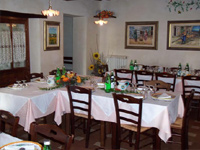 |
Dining at La Casella is a family affair, a very big family, which includes the owners, their families, guests, the farm workers and staff. It’s been a gray, misty day, softening the wooded hillsides outside the dining room windows. Sometime between the fagioli con scarola and the spaghetti con finocchiella, a rogue ray of sunlight breaks through the clouds and pierces the cobalt carafes on the table before me. Luciano puts down his fork and regales us with song. It’s a rousing affair, though I speak very little Italian, I know for certain that he’s lauding the sun. He finishes a verse, picks up a carafe and refills my wineglass. “Live the experience,” he whispers.
With great fortune, I’ve arrived during L’estate di San Martino during Italy’s Indian summer. Ambling down the country road, stepping carefully around puddles left by last night’s rainfall, all my senses are engaged. The sun warms my upturned face. There is a earthy aroma rising from fallen leaves and newly plowed soil. The colors of the countryside seem painted from their own unique palate. Hunting dogs bay in the distance, donkeys bray nearby. Cool water flows from a pipe that appears to flow directly out of the hillside. A handmade sign says: Fountain of the Madonna, I cup my hands and quench my thirst.
In tight formation, a group of mountain bikers approach, taking advantage of another offering of the agriturismo network: trekking. En route from one farm to the next, your hosts will meet up with you and serve you a tasty lunch. Your luggage is transported ahead and is waiting for your arrival. Dinner is waiting too, along with a shower and a comfortable bed. Trekking on horseback or on foot can also be arranged.
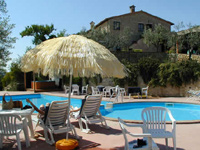 |
Whatever your perfect ideas of a holiday, chances are you can find an agriturismo property that will be ideally suited to your interests. Unspoiled medieval towns, sometimes just a hike away, offer up their bounty of art, cathedrals, history and architecture. Classes are taught in cooking, language, and art. Festivals occur throughout the year; Perugia is host to a world famous jazz festival as well as one in celebration of chocolate; Orvieto beckons with its medieval festival and a tribute to the Slow Food movement. In addition to trekking, horse lovers can take lessons in riding and dressage or participate in mock foxhunts. Real hunters can do that too when wild boar and deer are in season. Summer visitors can enjoy camping and the region’s beautiful lakes, and many properties have outdoor swimming pools. If you want to visit Roma or Florence for the day, trains run from many towns. You can take an early train in, sightsee all day, and return on a later train in time for dinner.
When it was time to return to Roma for my flight home, my heart was heavy. I felt I had merely scratched the surface of this abundant and friendly land. My ears reverberated with the words of Gianni Rivoli, owner of the Agriturismo Rivoli near Spoleto, “When the guests leave after a week, they cry.” I can certainly see why.
IF YOU GO... |
Most agriturismo properties maintain web sites, so it’s possible to do the research yourself to identify the perfect property for your needs. However, accommodations, prices and offered activities vary widely, so I would recommend you enlist the help of the Italian Public Tourist Board for Umbria.
Contact the Ufficia Promozione Turistica, Corso Vannucci 30, 06100 Perugia, (tel. (+39) 07550433676).
You could also increase your chances for the ideal holiday by working with a private consortium like Umbria in Campagna. The staff is very familiar with the properties they represent, and they speak English. During the high season (April-August), most places only accept one-week stays (or more). During the off-season, if you call ahead, you can often be accommodated for a night or two. |
|